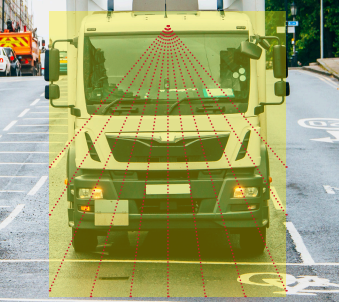OVERVIEW
MAX-SAFE Front View™ is an affordable camera-based solution designed to detect and protect people from advancing vehicles. It is suitable for a wide range of heavy vehicles such as tippers, concrete agitators, waste vehicles, prime-movers, buses, heavy machinery, etc. This advanced solution is mounted to the top of a vehicle’s cabin (typically above the windscreen). It can be combined with in-cabin alerts, a recording monitor, and exterior audible and flashing light warnings to provide greater safety to people around the front of a vehicle.
PROTECTING VULNERABLE ROAD USERS
Most heavy vehicles have front blind spots. The height, type of cab (bonneted vs cab-over), and size of the windscreen affect the number and size of the blind spots, making it difficult for
the driver to sight anyone close to a vehicle. This makes stopping in traffic and pedestrian crossings (or similar move-off situations) dangerous with three common risk scenarios: a pedestrian still crossing by the time the lights change (i.e elderly person, parent with pram, large group, jogger); a scooter operator racing to cross the road before vehicles move off; or a cyclist or motorcyclist that slips in unseen at the front or corner side of a vehicle to drive ahead of the truck. A heavy vehicle driver can move off and accidentally hit them due to the blind-spot at the front of their vehicle.
Sadly, this does happen – particularly when the truck driver notices a traffic light change before a VRU does. The smaller the person, the more at risk they are. It is common for pedestrians to be distracted on their phones or wearing ear buds, listening to something or someone. Hence the need to adopt safety solutions to protect people at the front of the vehicle and to keep our communities safer – helping to save the physical, financial and emotional hardship that comes with injuries and fatalities. Using the latest advances in AI and Machine Learning (ML) the MAX-SAFE Front View solution detects people within a configurable zone to the front of the vehicle.
HOW IT WORKS
The MAX-SAFE Front View solution uses state-ofthe-art camera technology to assist drivers to move a vehicle safely forward.
A camera unit is mounted on the top of the front cabin (above the windscreen) pointed downwards. It scans the incoming image to determine if it recognises a person within a defined danger zone, either moving or stationary. It does this by using in-built AI (Artificial Intelligence). On detection of a person within the danger zone, the system reacts instantaneously by triggering a range of options.
A recordable monitor can be added (not mandatory) across any of the options to provide the driver with vision of what the camera is seeing (with the danger zone outlined) – while
capturing video for later retrieval. The MAX-SAFE Front View solution protects vulnerable road users and other vehicles, giving drivers greater confidence and certainty when taking off or driving at low speeds.
HOW FITTED
The system has been designed to fit on side mirrors or on top of the cab and can be installed in new fleet builds or easily retrofitted. After it is installed, the system is calibrated before use.
- PLACEMENT: The camera is mounted on the top of a vehicle’s cabin (above the windscreen).
- CABLING: The cables are routed along the vehicle’s body and into the cab.
- INSTALLATION OF THE WARNING SYSTEM: The buzzer and light are mounted on the A-pillar.
The MAX-SAFE Front View™ solution is designed to protect vulnerable road users and site workers and provide certainty for drivers moving forward.
BENEFITS
◆ PROVIDES ASSISTANCE to the driver.
◆ SAFEGUARDS the front of the VEHICLE.
◆ PROTECTS PEDESTRIANS, cyclists and motorcyclists.
◆ HIGH ACCURACY – detects people (stationary and moving).
◆ MORE AFFORDABLE than sensor systems.
◆ SUITABLE for most ANZ CONDITIONS.
◆ Can provide ALERTS and AUDIBLE WARNINGS.
◆ STATE-OF-THE-ART AI GERMAN TECHNOLOGY.
◆ GREATER SAFETY and PEACE OF MIND – including for
Fleet Managers.
◆ Part of the MAX-SAFE SAFETY ECO-SYSTEM.
Contact us if you would like a quote for your vehicle fleet or individual vehicle.

